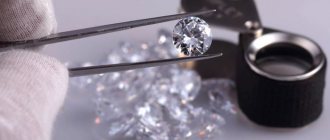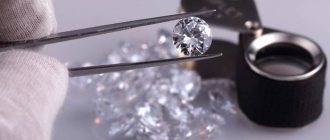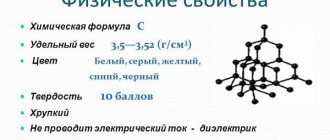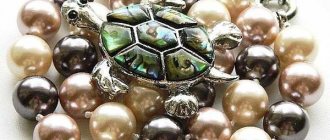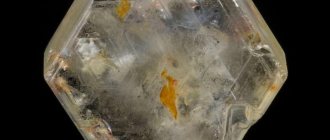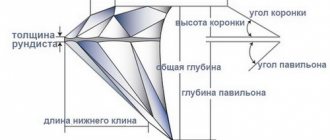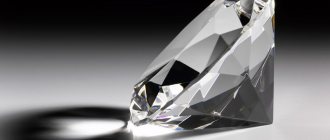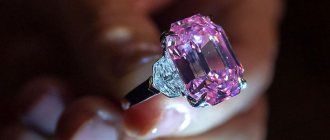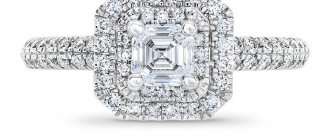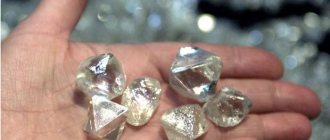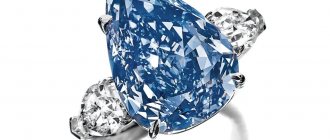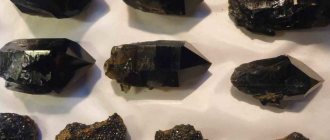Now we will tell you how to distinguish a real diamond from a fake. After all, there are a number of transparent minerals similar to it. They can be quite beautiful and also sparkle in refracted rays, thanks to the high-quality cut. Yes, but they are much cheaper. Professionals have many methods that they use to determine the authenticity of an expensive stone. It does not bother them at all if the jewel is in a piece of jewelry, for example, in a ring.
First there was a knife
First, let's figure out what natural stone looks like. And only then we’ll talk about how to identify a real diamond.
Until the mineral is cut by a master, it looks faded. Yes, and at first they call it a diamond. Its density is 3.5 g per square meter. cm. It is this high indicator that distinguishes it from other stones.
People have been making cutting objects from it for a long time - grinding wheels and discs, drills and knives. It is also used for the needs of the nuclear industry, quantum mechanics and microelectronics. And this crystal turned into a diamond when craftsmen were found who were able to cut its edges at different angles so that they sparkled with light. To do this, it was necessary to understand its structure, study the properties of the semiconductor, and determine the energy.
And then it turned out that diamond is an allotropic cubic form of carbon. You will find more detailed information about this in the article “What is a diamond and what is it for?”
The Mystery of the Blue Diamond
The Hope Diamond, weighing 45.52 carats, is considered the largest blue diamond in the world. It was he who first showed people that blue diamonds can, under certain conditions, become red-red, like a flame. It and 66 other natural “brethren” were studied by employees of the American Naval Research Laboratory, the Smithsonian Institution and the University of Pennsylvania (Pennsylvania State University).
The Hope is the largest blue diamond in the world and is central to the collection of the Smithsonian Institution National Museum of Natural History, to which it was gifted in 1958 by renowned jeweler Harry Winston (photo NMNH)
“What added to the intrigue was the fact that most blue diamonds glow not red at all, but green-blue light,” says lead researcher Sally Magaña.
It turned out that each such stone has “fingerprints” that people were previously unaware of. But we are getting ahead of ourselves.
To finally understand why the famous diamond emits red light for a while after being illuminated with ultraviolet light, scientists used various spectroscopic methods.
A puzzle that has tormented scientists for years: why a diamond continues to glow red for several seconds after the stone is illuminated with ultraviolet light (photo by John Nels Hatleberg)
“If you wanted to do a spectral analysis of such a rare diamond, you would have to bring a spectrometer to a museum, under no circumstances would you be able to bring Nadezhda into your laboratory,” adds one of the researchers, professor of mineralogy Peter Heaney from the university Pennsylvania.
It is for this reason that Ocean Optics created a special portable spectrometer, which restless physicists had to install right in the National Museum of Natural History.
Experimenters tested a variety of natural blue diamonds, including “Nadezhda” and the second largest “Blue Heart” weighing 30.82 carats, which belongs to the Aurora Butterfly collection and, together with several stones, temporarily kept “Nadezhda” company in the same museum.
The Aurora Butterfly collection consists of 296 natural colored diamonds (not all shown in this image). It was the presence of such a large number of precious stones in one place (at a temporary exhibition) that allowed scientists to achieve impressive results in unraveling the mystery of the red glow (photo by Robert Weldon).
Magaña and her colleagues determined the wavelengths of light emitted by the stones after irradiation with ultraviolet light, as well as the rate at which the glow decays. It turned out that all blue diamonds phosphoresce red or luminesce green-blue, each in its own way. Such as “Nadezhda”, the phosphorescence of red light predominates (the emission intensity of green-blue light is much lower).
Surprisingly, the size of the diamond does not depend in any way on the duration or brightness of the glow. Thus, “Nadezhda” phosphoresces for 8.2 seconds after irradiation, and the record holder was a lesser-known gem that “lasted” for 28 seconds.
“Most likely, this property was first found in the largest blue diamond, because in the dark, due to its size, it looks like an unextinguished coal,” says Sally.
“People believe that Nadezhda is valuable only from a historical point of view, but, as we see, for science, this diamond is a rare sample, important for research, for understanding the processes that occur during the formation of diamonds in the thickness of the earth’s crust,” adds Jeffrey Post, curator of the national gem collection, in a Smithsonian press release.
Scientists suggest that phosphorescence is characteristic of blue diamonds due to the presence of boron atoms in their structure (boron, in addition, determines the blue color of stones in daylight). Temperature analysis of phosphorescence showed that its cause is probably the recombination of the carbon-boron donor-acceptor pair.
However, the latter conclusion is still in question, since 5 out of 67 blue diamonds did not glow after irradiation. Physicists suggest that they have a different structure than all other stones.
The artificial diamonds studied by scientists earlier behaved in exactly the same way - they did not glow. So these pebbles, as the researchers have established, do not have any special spectral “autographs.” Even those that were deliberately made to imitate blue diamonds.
Details of the study can be found in the authors' article published in the January issue of the journal Geology.
Scientists, of course, are simply curious to know how this or that unusual phenomenon “works.” But for the whole world, the practical application of this discovery will be much more interesting: now any known (and even just natural) blue diamond can get its own data passport, which will indicate the exact characteristics of the emitted spectrum and the decay time of the glow, by which it will be possible to determine the authenticity of the stone.
In addition, historians may be able to clarify the history of “life” and the largest blue diamond.
The diamond, which is the progenitor of “Hope,” was discovered at the beginning of the 17th century in India (and, according to some sources, weighed 112 carats at that time), was cut many times, was stolen several times and was returned again. Historians claim that the diamond was divided into pieces or smaller diamonds were separated from it. Accordingly, if they are ever found, then it will not be at all difficult to establish their relationship with “Nadezhda” by their spectral “signature”. Just like the relationship of other rare diamonds to each other.
Found a typo? Select a fragment and press Ctrl+Enter.
Tags: Obvious and incredible diamond blue diamond gemstone ultraviolet
Previous article New glass. Semiconductor with diamond hardness
Next article Molecules that prevent skin aging
Provided by SendPulse
Likes 0
- 0
- 0
- 0
- 0
Suitable for counterfeiting
Diamonds can be checked for authenticity at home or in a laboratory. There are many similar transparent colorless stones in the world. If necessary, they are used to make cheaper copies. And if you don’t understand anything about jewelry, then they can easily be confused with the following artificial and natural materials:
- cubic zirconia;
- zircon;
- quartz;
- topaz;
- moissanite;
- artificial diamond.
Ordinary light will help you identify a diamond among them. After the stone is processed, it enters through the crown. Then it is reflected from the edges at the back, as if from mirrors. The simplest inspection tool is a magnifying glass. Through it, you can see small areas that are poorly visible to the ordinary eye and that have not been treated. They do not affect the beauty of the mineral and are left by the master specifically for visual crystallographic orientation.
Below we will explain in detail how to distinguish a diamond from a fake using different methods.
Professional methods
To use the methods described in this section, you need to have some experience. At a minimum, visually examine several diamonds (which have already been verified) and similar shaped fake stones in order to understand from experience how to distinguish a diamond. However, we present them here as the most reliable and do not require special equipment, and therefore do not cause certain difficulties.
Light
Glass reflects light rays, creating reflections around itself. The diamond seems to accumulate light within itself and is distinguished by its natural brilliance. Depending on the cut, it turns the rays either into a bright point inside or into a uniform halo around the perimeter. Therefore, you need to take the stone out into the sun or place it under a very bright lamp. Then it will be easy to distinguish between a natural and artificial diamond.
See how a genuine stone sparkles.
Comparison
You can get a fairly accurate result if you look at a cut piece of glass or quartz under a magnifying glass, comparing its texture with the texture of the stone. Please note that glass often has stains or scratches, but diamonds do not.
You can also see inclusions in the diamond, indicating its natural origin. Diamond classification table by clarity group →
Distortion
Here is another test of the diamond's authenticity. Place it on the pages of the book. If the letters cannot be read through it or they are greatly distorted, then the stone is genuine. The power of refraction of rays in a real stone will allow you to immediately understand how to distinguish a diamond.
A genuine stone will not be transparent like cubic zirconia or glass. You won't be able to see your fingers through the real diamond in the ring.
Weight
If you are wondering how to check the authenticity of a diamond by weight, get yourself a small, accurate scale and a chart of the size and weight of different minerals. You'll quickly realize you're dealing with a fake if you see that a diamond of the same size should weigh more or less. For example, zirconium, which is often counterfeited as a diamond, is much heavier.
Frame
Checking a diamond in a setting is very simple. If it is inserted into a piece of jewelry made of cheap material, such as silver or, especially, steel, the diamond is not real. Gilt silver will be marked accordingly, so always look for a hallmark on the metal. If the product is marked “CZ”, it means that the stone was grown artificially.
Ultraviolet
Natural diamond luminesces under a UV lamp. However, like synthetic. But there is a way to distinguish a natural mineral from an artificially created one: after turning off the lamp, the latter will phosphoresce.
Harder than artificial crystals
In the laboratory, to determine whether a stone is fake or not, its hardness is determined when examining a crystal. On the Mohs scale it is 10. This means that a real diamond will scratch all other minerals that are softer than it. And this is one of the verification methods that determines the authenticity of the mineral.
In order not to spoil other “softer” gems during the experiment, synthetic abrasives are used. For example, if you run a diamond edge across polished carborundum, a mark will certainly remain. It will not disappear even if you wipe it with a finger moistened with water. In this case, there is no doubt that the stone is real. The same mark will be left by a diamond on strontium titanate. This is another representative of an artificial material, similar to diamond, but very different from natural one.
Using a refractometer, the refractive index of rays is determined, which should be 2.42 for a diamond. This is precisely why it differs from similar materials – colorless sapphire or spinel. An important point during research is that the diamond cannot be placed on the glass prism of the device, as it can damage the “softer” glass.
How to distinguish a diamond under ultraviolet and x-rays
Now we will explain how to identify a diamond if it is too small. It happens that because of this it is impossible to detect the refractive index using a special device. Then the jewelry is placed in a solution of methylene iodide. The edges of the diamond will be visible very clearly, but the stones imitating it will literally disappear in this liquid.
Another characteristic feature of diamond is the so-called birefringence. It is determined by placing a diamond between crossed polaroids. Holding the mineral with tweezers, examine it in such a way that your gaze is directed towards the girdle. The indicator is due to the presence of internal tension in the stone and shows a series of dark stripes and bright spots.
We will also tell you how to identify a diamond using ultraviolet rays. Under their influence, fluorescence occurs. A quartz mercury lamp with a special filter (Wood glass) can also be used. Most often, diamonds fluoresce blue or yellow. Moreover, the glow continues for some time after the end of exposure to ultraviolet radiation, when the device is already turned off.
But that is not all. If you look at a diamond under X-rays, it has a bright bluish glow. In addition, this way you can accurately determine the transparency of the stone. Since the carbon that makes up the crystal is transparent to X-rays. Imitations or other precious minerals are not allowed through.
Traditional methods of verifying the authenticity of a stone
Often there is a desire to check a diamond at home - out of curiosity or a desire to make the right investment. The following are tips that will teach you how to identify a real diamond if you do not have special experience, knowledge, skills or tools like an ultraviolet lamp.
Water
Put a diamond in water to see if it is fake or not. The original will disappear. That is, of course, it won’t go anywhere, but it will become almost invisible. On a real diamond (although on glass too) chips and scratches will be noticeable. This will help identify another type of counterfeit - when a natural stone is replaced with an artificial one.
Breath
Just breathe on the product. A real diamond will not fog up like a fake one, and it will not be difficult to correctly determine its authenticity. But the glass fogs up very quickly. The surface of many artificially grown crystals also sweats.
The ease of this method allows you to use it anywhere. Even directly in a jewelry store, if right there you were wondering how to distinguish a real diamond from a fake one. Natural stones are easily identified this way.
Price
There is another way to determine the authenticity of a diamond in a store. This is its cost. Diamonds will not be sold cheaply, even on special offers and in “cheap” stores. Check the price of high-quality real diamonds before you go shopping, and then you can immediately determine the originality of the stone.
Scratches
If you have corundum, try scratching the diamond with it. The density of diamond will not allow you to leave even a small mark. How to recognize a fake if there is no corundum? You can use plain sandpaper, although it will not give such an accurate result. However, if even she damaged your pebble, know for sure that it is not real. The main thing is to check that the paper is without diamond chips.
In any case, when checking a diamond, remember that only gemological examination can accurately establish its authenticity. Here are just the basic simple methods suitable for any conditions.
Read also: how to distinguish a diamond from cubic zirconia →
Defects confirm authenticity
Having the knowledge and necessary tools in their arsenal, professionals almost never make mistakes when checking diamonds for authenticity. As mentioned above, working with diamond requires a magnifying glass. It should increase visibility by at least ten times.
As a rule, all diamonds have some inclusions of foreign impurities. They look like dark spots. Most often these are graphite or magnetite, and there are about two hundred of them in total. The presence of inclusions indicates that the diamonds are genuine.
However, spots somewhat spoil their appearance. Now experts have learned to deal with “defects” using laser and acid. So, if a diamond shows a mark from a laser beam, then there is no doubt about its authenticity.
Known for laboratory research to determine the quality of diamonds and American cutting. The jewelry they put on sale is certified. For more information, see the article “Diamonds vs. Other Stones.”
Field test of Diamond Inspectors
08/06/2021 Gemology 662
Alexey Lagutenkov
Website: Go
Independent expert gemologist. Academic titles: GG GIA (Chartered Gemologist, Gemological Institute of America), AJP GIA (Accredited Jewelry Professional of the Gemological Institute of America), MBA Kingston University UK (Master of Business Administration from Kingston University UK).
Author of the best-selling book "Gemstones".
Other expert publications:
- Evaluation of colored jewelry stones. Introduction to the "World of Color" from GemGuide
- Synthetic Diamonds 2020
- How to evaluate a gem or a game without rules
- Let's talk about the new GOST for diamonds
- Sapphirite Madness
July 2021 turned out to be not only hot, but also very interesting! Thanks to Alrosa Technology, two of their devices, “Diamond Inspector” and “Diamond Inspector View” (Photo 1), came into my hands. We did not stipulate any special operating conditions for the devices, other than not to drop or disassemble the devices, and also not to scratch swear words on the case. Among other things, this was a completely free, non-commercial trial for which I did not charge a penny. In exchange for this, I received the right to write about this family of devices completely unbiased, without advertising enthusiasm and praise. Needless to say, this is a rather bold step on the part of Alrosa Technology, which speaks of their confidence in the quality of the device.
Photo 1. “Diamond Inspector” (left) and “Diamond Inspector View” (right). Alrosa Technology.
I have already written about the “Diamond Inspector”, however, it is one thing to conduct a theoretical conversation that, supposedly, there is such a device in nature and its hypothetical characteristics, in general, are probably not bad. It’s a completely different matter to work with such equipment live! I am also very grateful to the Russian company IQDiamonds, which provided free samples of laboratory-grown diamonds (from the English Laboratory Grown Diamonds or LGD) and jewelry with them for honest and independent tests.
Let’s say right away that “Diamond Inspector” and “Diamond Inspector View” are not “pocket devices. They can be called “portable”, but not pocket-sized. Comparing them in size and weight to, say, the Smart Pro or Veritas Gemtrue makes no sense! Domestic high-tech devices are frankly larger in size and weight. Is this justified? Let's watch!
First of all, I was interested in the fact that the Diamond Inspector supposedly uses not a simple set of filters and UV LEDs, like most pocket-sized foreign inexpensive devices, but three real, full-fledged spectrometers: Raman, UV and visible range.
It is impossible to verify the actual presence of all three measurement methods from a photograph and one appearance of the device. Only the gods know what is inside that black box. Right? Not so in the case of The Inspector. Once you connect this device to your computer via USB, install the software and press a button on the device, after a couple of seconds an Excel table file opens on your PC with three graphs: “Ultraviolet absorption spectra” in the range from 199.5 to 343.5 nm, “Visible fluorescence” from 399.1 up to 664.5 nm and “Raman Spectroscopy” from 541.8 to 664.5 nm. In addition, during operation, you can hear the operation of some mechanics inside the device. Apparently, the “Inspector” physically moves certain filters inside itself during the measurement.
If in diamonds and jewelry business you are only interested in the price and “to whom to sell?”, then in this case the “Inspector” has an indicator on the front panel that shows in Russian or English: “Natural diamond”, “Refined”, “Type IIa” (IaB)” (this is how LGD diamonds are grown in a laboratory), “Malinger” or “Research Required!” True, I will hardly ever be able to understand such incurious people!
“Advanced” analysis of rough and polished diamonds allows you to look at their jewelry essence from a completely different perspective! If previously a gemologist was “blind” and judged loose diamonds or stones in a product only by indirect methods, now any specialist can gain “spectral vision”!
However, let’s get down to describing personal impressions of working with the devices!
It is unlikely that anyone in our time will have big problems identifying cubic zirconia or moissanite. These simulators are relatively easily caught by all kinds of pocket testers. Their difference from diamonds can be seen under a microscope. In the end, you can always measure the specific gravity: cubic zirconias are much “heavier” than diamonds, while moissanites, on the contrary, are up to 10% lighter. However, these are indirect methods. What if, say, an expert gemologist has to prove the fact of stone substitution in court? Tell the judge that the pocket tester “beeps” on diamonds, but in our case it “does not beep” and, therefore, the sample being examined is not a diamond? What if you come across not cubic zirconia, but moissanite with low electrical conductivity, which behaves on the simplest devices like a full-fledged diamond and “squeaks” correctly where it is required?
I conducted my first study of Diamond Inspector on malingerers. At my disposal were 22 cubic zirconia from different suppliers and 31 moissanite. Cubic zirconia and moissanites turned out to have uniquely definable Raman spectra. Peaks are characteristic of cubic zirconia at 545 and 548 nm (Photo 2), and for moissanites at 555 and 560 nm (Photo 3). For comparison, natural and synthetic diamonds have a pronounced peak at 573 nm (Photo 4).
Photo 2. Raman spectrum of cubic zirconia
Photo 3. Raman spectrum of moissanites
Photo 4. Raman spectrum of natural diamonds
The presence of a Raman spectrometer in the Inspector, naturally, caused an irresistible desire to test colored stones as well. Unfortunately, nothing came of this idea. In some cases, too strong luminescence “overwhelmed” the Raman readings; in other cases, the spectrum turned out to be insignificant. In all cases, the “Inspector” indicator confidently showed “Sham”, and the spectra of some stones are shown in (Photo 5).
Photo 5. Raman spectra of pink spinel, pink sapphire and greenish-blue apatite obtained using Diamond Inspector from Alrosa Technology
Perhaps the experience of working with the device on non-diamonds was one of the simplest phases of testing. It was easier to work with colorless and almost colorless natural and laboratory-grown diamonds in the DJ GIA color range.
Thanks to a Moscow pawnshop, who asked not to be named, I had 7 natural, almost colorless diamonds at my disposal for research, weighing from 0.03 to 0.21 ct, FJ color groups.
IQDiamonds provided 15 LGDs grown using HPHT and CVD technologies. On all these stones, the “Inspector” did not make a single mistake, 100% confidently distinguishing laboratory-grown stones from natural ones. At this stage of research, the second device from Alrosa Technology, Diamond Inspector View, brought noticeable benefits.
This device can show fluorescence in long-wave 365 nm and short-wave 254 nm ultraviolet. A distinctive feature of “Inspector View” is the presence of a potentiometer that allows you to adjust the intensity of UV radiation, as well as the presence of a “Phosphorescence” button, which allows you to instantly turn off any lighting and observe the phenomenon of phosphorescence, which appears only in laboratory-grown diamonds, when after irradiation with ultraviolet light , these stones continue to glow on their own for some time in complete darkness. The fact of phosphorescence quite often indicates the laboratory origin of a diamond, with a high probability of being grown using HPHT technology. Perhaps this was one of the most beautiful phases of research into the operation of devices!
Most natural diamonds exhibited typical fluorescence: a moderate bluish-blue in the long-UV and a much weaker, greenish-blue in the long-wave. There were no non-fluorescent natural stones in my sample.
Photo 6. Fluorescence of LGD in long and short UV, obtained using Diamond Inspector View from Alrosa Technology
The situation with LGD turned out to be much more interesting. If the CVD diamond looked rather boring in Inspector View, showing no activity in the UV, then the HPHT more than compensated for all my curiosity! For example, the cross pendant (Photo 6) and one of the colorless diamonds showed amazingly long phosphorescence.
Photo 7. Diamond fluorescence in long- and short-wave UV
The next stage of testing was slightly beyond the scope of the documented capabilities of the Inspector, but, as they say, when else will I get my hands on the Raman? The pawnshop provided me with an additional 16 diamonds of unknown origin, KU color group. Three stones from this sample interested me because the Veritas “Gemtrue” screener confidently identified them as natural diamonds, while the “Diamond Inspector” stubbornly insisted: “Investigation required!” The fluorescence of all three stones is approximately the same: a moderate dark blue in the long UV and a slightly more intense greenish-blue in the short wave (Photo 7).
Sample number one has a peak in the ultraviolet absorption spectrum at 257 - 288 nm, characteristic of synthetic diamonds (Photo 8).
Photo 8. Diamond Inspector's testimony for Sample N1
Photo 9. Diamond Inspector's testimony for Sample N2
Photo 10. Diamond Inspector's testimony for Sample N3
Sample two shows a less pronounced peak in the same spectrum at 263 – 281 nm (Photo 9).
Sample number three is the most interesting (Photo 10). It does not have characteristic peaks in the ultraviolet absorption spectrum, but in the Raman spectrum a peak at 656 nm is clearly visible. If you open the book by R.A. Khmelnitsky “Introduction to Diamond Gemology” on page 109, then you can read the following: “2.4 The presence of nickel optical centers (658 and 883 - 884 nm) indicates an HPHT crystal.” According to Dr. V.G. Vince, the peak in the Raman spectrum at 656 nm is a band of impurity nickel, which indicates that this is a diamond grown in the HPHT laboratory, obtained in the Fe-Ni-C + Ti system.
Thus, all three dubious diamonds, which are identified as natural by the SmartPro and Veritas “Gemtrue” screeners, look dubious to the Diamond Inspector and are most likely synthetic stones.
The documented, “permitted according to instructions” capabilities of Diamond Inspectors ended there. Alrosa Technology categorically does not recommend experimenting with fancy diamonds, since the measurement results will obviously be incorrect. However, when you have fancy blue, yellow and red LGD samples from IQDiamonds on hand, it's simply a sin to miss this opportunity!
Fancy Vivid Yellow HPHT 2.07 carat (Photo 11), according to the certificate, has the characteristics of Fancy Vivid Yellow SI2. No peculiarities were noticed about him. Raman showed a peak at 573 nm (Photo 12), UV and visible fluorescence absorption spectra are not representative. The stone turned out to be absolutely indifferent to long- and short-wave ultraviolet radiation and did not show any visible fluorescence. In this case, using the “Inspector” you can make sure that it is definitely a diamond, but you will not be able to establish the nature of its origin.
Photo 11. Fancy yellow FVY SI2 laboratory grown HPHT diamond, weighing 2.07 carats. Provided by IQDiamond.
Photo 12. Diamond Inspector readings for HPHT FVY 2.07ct
Next, fancy blue diamonds were tested. The first sample is a Fancy Blue VVS2 HPHT diamond, weighing 0.8 kt, cushion cut (Photo 13). The inspector identified it as a “natural diamond,” which cannot be blamed on the device. On the Raman spectrum we observe the already familiar 573 nm (Photo 14). I have no explanation for the peak at 217 nm in the fluorescence absorption spectrum and 447 nm in the visible fluorescence graph. With the help of Diamond Inspector View, it was possible to establish that the stone is absolutely neutral to both ultraviolet ranges.
Photo 13. Fancy blue FB VVS2 laboratory grown HPHT diamond, weighing 0.8 carats. Provided by IQDiamond.
Photo 14. Diamond Inspector readings for HPHT FB 0.8ct
The second sample is synthetic Fancy Blue SI1 0.82 kt, the production process of which is unknown. There is no information whether it was created using HPHT or CVD (Photo 15). The "Inspector" identified it as a "Natural Diamond". Peak 573nm on Raman (Photo 16) and again a complete absence of fluorescence in Inspector View.
Photo 15 Fancy blue FB SI1 laboratory grown HPHT diamond, weighing 0.82 carats. Provided by IQDiamond.
Photo 16. Diamond Inspector readings for HPHT FB 0.82ct
Finally, the last guest is a complex deep red diamond weighing 0.53 ct (Photo 17). This stone was refined in Novosibirsk using the patented Multistep technology, the rights to which belong to Velman LLC and V.G. Vince. As a result of four stages of refining, the yellow-brown LGD turned into a beautiful diamond of a rare red hue.
Photo 17. Fancy red FR laboratory grown HPHT diamond, weighing 0.52 carats. Characteristics not defined. Provided by IQDiamond.
Photo 18. Diamond Inspector readings for HPHT FR 0.52ct
Photo 19. Fluorescence HPHT FR 0.52ct in “Diamond Inspector View”
Red diamonds go very far beyond the competence of the Diamond Inspector, so the device identified this stone as a “Sham”. From the graphs it was possible to remove only the Raman spectrum, which is absolutely unremarkable (Photo 18). The diamond exhibits bright red fluorescence in both ultraviolet ranges (Photo 19).
Alrosa Technology specialist Elizaveta Volkova explained the behavior of a red diamond when examining it with the help of the Diamond Inspector: “The situation, in principle, applies to all red diamonds. UV excites their own red glow in them, which falls on the red region of visible light. The ends of this “mound” of fluorescence stretching to the left and right also overlap that part of the spectrum where the Raman peak of all diamonds is usually located. If this fluorescence is more intense than the Raman peak, or if it extends further towards the UV, then it will simply cover it. In this case, our device does not see the emission at 572 - 573 nm and, quite reasonably, decides that the material under study is a simulator. This is exactly what happened with the red stone you tested. If you look closely at the last graph, you will notice that the fluorescence is so intense that it completely covers this peak.”
What conclusions can be drawn from this small study?
The combination of the Diamond Inspector and Diamond Inspector View devices allows for little money, about $7,500 dollars, to determine the nature of origin (natural, synthesized in the LGD laboratory) of any colorless and almost colorless diamond in the GIA DJ color nomenclature. Without additional effort and measurements, “Inspector” quickly identifies the most popular simulators. Despite its fairly large size, the Inspector consumes surprisingly little electricity. When powered by a power bank and almost continuously used for a week, the battery was discharged by only 2%. "Inspector View" is good for adjusting the brightness of the UV flux. This makes it possible to observe fluorescence and phosphorescence even in those diamonds that have the “None” characteristic in the gemological report.
Among the shortcomings of the Inspector, it should be noted that the instructions are rather “poor”, which describes only the basic functions of the device, without the use of a computer. In the device description you will not find any descriptions of the spectra or explanations of where to look on these spectra. The main drawback of Inspector View is the loose tray, which can fall inside the device during transportation. Yes, this tray is easy to remove, but when this happens for the first time, the incident is, let’s say, frightening.
Some time ago, I wrote about the behavioral features of consumerism of generations Y and Z. One of these features is distrust of authorities and the desire to double-check everything “here and now.” If “baby boomers” do not even need to prove that the stone in the jewelry is a diamond, they take the seller’s word for it, then “millennials” and “zoomers” may demand proof. If you install “Inspectors” in a retail jewelry showroom, having previously printed and hung pictures of spectra on the wall, you can potentially attract the attention of new generations with a sort of “gadgetized, high-tech show.” Moreover, it does not matter at all whether the salon specializes in selling natural or laboratory-grown diamonds. In both cases, clients can be charmed by an abundance of evidence and scientific information.
(c) A.A. Lagutenkov 2021
Gallery
We check with a tester
One of the devices for determining the authenticity of diamonds is called DIAMOND SELEKTOR II. It is most often used as a tester for diamonds and moissanites, but it also reacts to other stones.
Let us explain step by step how to check a stone using a tester. The device operates on batteries based on the principle of thermal conductivity, so after turning it on it must be warmed up. Then, on a special scale, the approximate dimensions of the stone being examined and the air temperature in the room are established.
We hold the metal plate in the shape of a triangle located in the back with our finger. Using the “sting” on the side, we touch the crystal in the plane of the face. If the light bar on the front fills up, it is a genuine diamond. At the same time, an audible signal sounds. And if the light elements do not work fully, it means that the product contains fake stones.
In appearance and characteristics, the mineral moissanite, containing silicon carbide crystals, is very similar to diamond, but differs in less sharp fusion of the faces and smoothness of the girdle. Diamond can scratch it. Read more about this in the article “What kind of stone is moissanite and how to distinguish it from a diamond.” The above apparatus is not suitable for testing artificially created moissanite.
